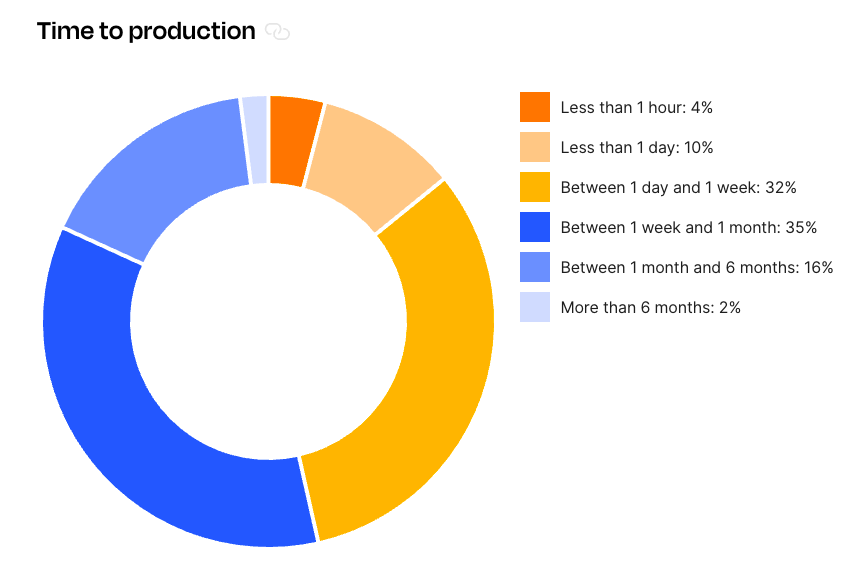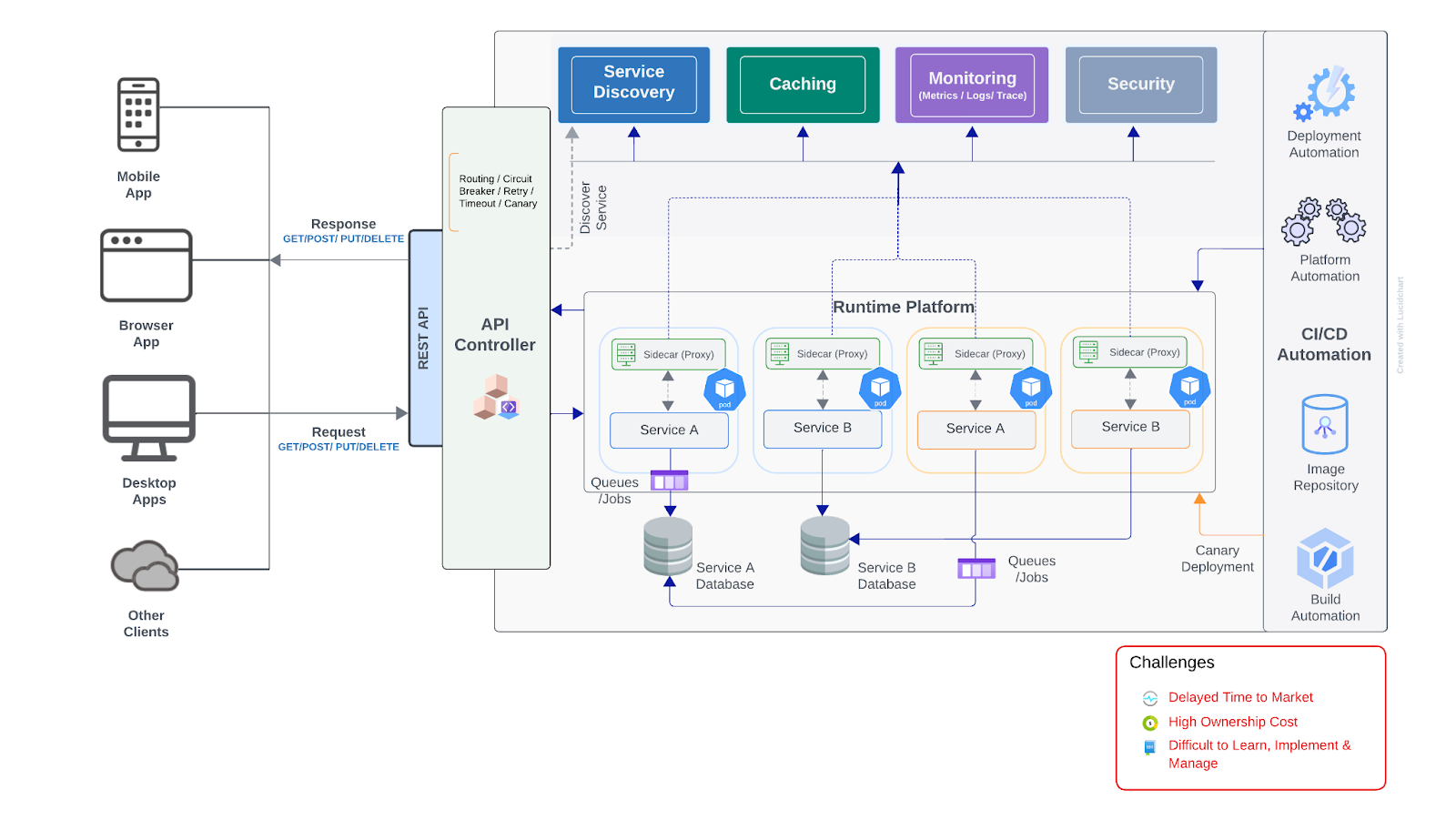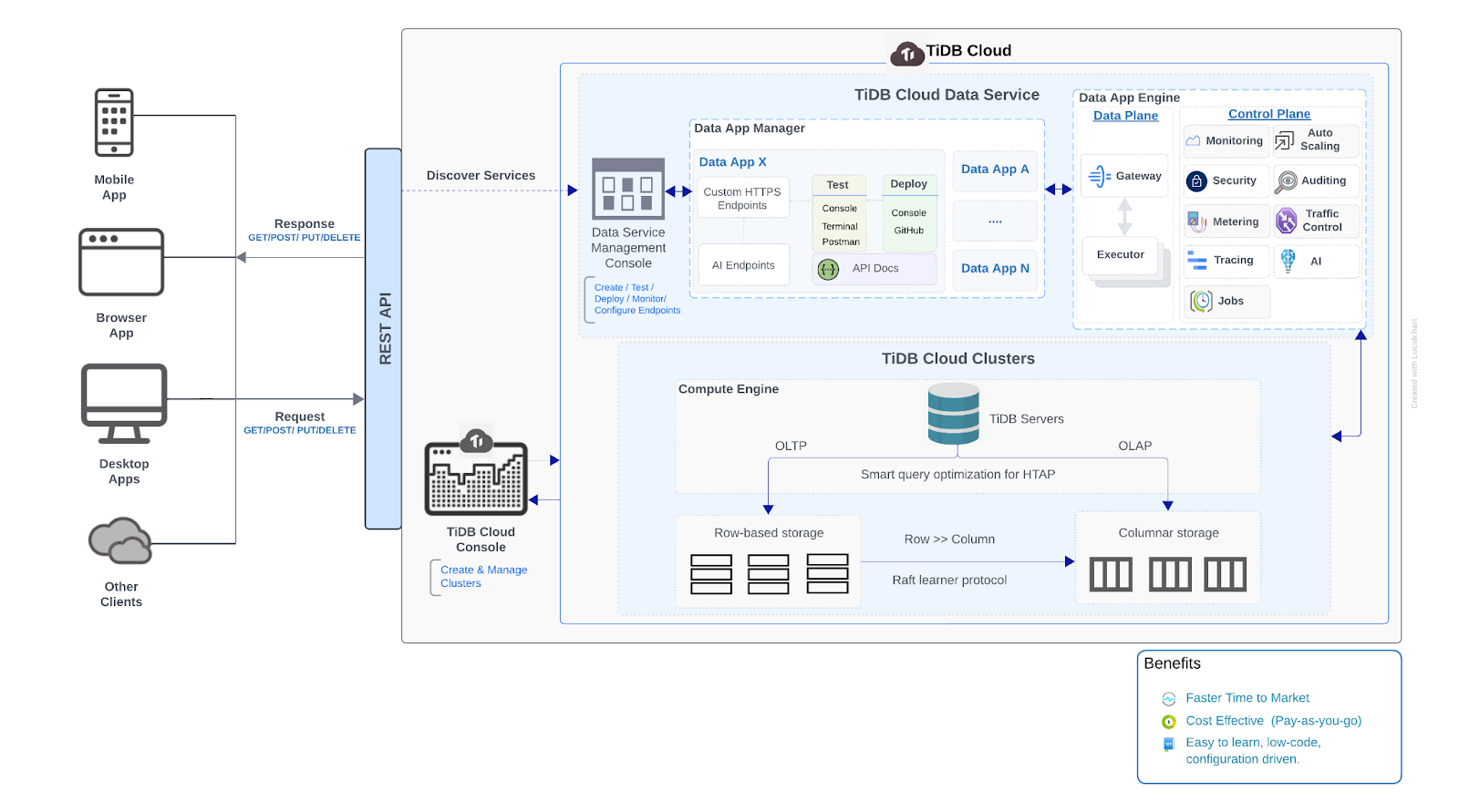Embracing Low-Code Development for Backend Apps With TiDB Cloud Data Services
Explore how TiDB Cloud Data Services streamlines backend application development and overcomes the challenges of building RESTful APIs in the API-first era.
Join the DZone community and get the full member experience.
Join For FreeIn the dynamic application development landscape, the API-first strategy has emerged as a cornerstone for fostering agility and scalability. By prioritizing API design and development from the get-go, this strategy facilitates seamless integration across various systems and applications. However, despite its merits, the road to achieving a robust API-first approach isn’t without its hurdles. Specifically, developers often encounter challenges in backend management, particularly when building RESTful APIs—a go-to choice for microservices communication. What’s needed is a low-code development data service for building backend apps.
Enter TiDB Cloud Data Service (TCDS), an innovative new feature of TiDB Cloud designed to redefine how developers harness backend capabilities. Built upon TiDB Cloud, the fully managed database service of TiDB, TCDS offers a fully-managed backend-as-a-service solution that bridges the gap between databases and comprehensive backend management.
In this post, we will explore how TCDS streamlines backend application development and overcomes the challenges of building RESTful APIs in the API-first era. Additionally, we will draw insights from Postman’s 2023 State of API report to substantiate our observations.
Challenges in Embracing API-First for Building APIs
The API-first approach is a strategy that treats APIs as “First Class Citizens” in application development. This approach makes development super easy, resulting in faster time-to-market, reduced costs, improved developer productivity, enhanced collaboration, and risk reduction. It’s not just a strategy; it’s an innovation catalyst.
However, the truth is that only a limited number of organizations have been able to implement this strategy successfully. According to the 2023 State of API Report, only 19% of companies have been able to envision, implement, test, and rapidly deploy an API in a production environment. Specifically, these organizations embrace the API-first approach for building RESTful APIs.

Building APIs – Time to Production
There are many challenges and roadblocks inhibiting the adoption of the API-first strategy and consequently causing delays in API development.
Limited Developer Resources and Expertise
Building and managing APIs require specialized skills and knowledge. This poses a challenge in finding and retaining qualified developers, which leads to API development delays and quality issues. Additionally, the development process involves a steep learning curve and repetitive tasks like database management, billing, monitoring, and high availability. These inefficiencies slow down development speed and demotivate developers.
Lack of Infrastructure for API Development
Building and managing APIs for microservices architecture requires specialized infrastructure like service meshes and container orchestration platforms. This often involves substantial upfront investments in hosting platforms and third-party vendors for critical functionalities like caching, observability, and routing. This prolonged and costly process delays time-to-market and may lead to expensive vendor contracts that impede flexibility and scalability.
No Centralized API Management Solution
As the number of endpoints in an API ecosystem grows, it becomes increasingly challenging to manage and scale APIs effectively. Without a centralized API management solution, it can be challenging to maintain consistency and visibility across multiple APIs. To mitigate this issue, companies can invest in API management tools and platforms that facilitate or even automate common management tasks. This again requires special expertise and augmenting costs.
Lack of a Standardized Approach for Designing and Building APIs
Without a standardized approach that covers documentation, programming language, configuration, and deployment options, it is challenging for developers to reach a consensus on the most effective approach to API design and development. These discords can introduce inconsistencies in API design and long-term maintenance and scalability challenges.
While we’ve explored the challenges and roadblocks hindering the widespread adoption of the API-first strategy, it’s valuable to note that these issues are not isolated incidents. In fact, the 2023 State of API report has identified obstacles that closely align with the challenges we’ve discussed.

Challenges Building API – Delayed Time to Production
How Can TiDB Cloud Data Services Help?
TCDS emerges as a fully-managed backend-as-a-service solution that bridges the divide between databases and comprehensive backend management. It empowers developers to construct highly scalable, data-driven applications easily and precisely. In this section, we will probe into how TCDS streamlines backend application development and addresses the previously discussed challenges.

Benefits of Considering Data Services
Build and Deploy Endpoints (APIs) in Seconds With Low-Code Development
TCDS offers an intuitive, low-code development approach to building backend APIs, catering to both seasoned application developers and citizen developers. Notably, by leveraging Chat2Query AI endpoints, even those with minimal prior knowledge can rapidly create complex SQL queries and build backend applications aligned with business requirements. Furthermore, The Autogenerate Endpoints feature simplifies the process, allowing developers to generate and deploy CRUD endpoints with just a few clicks.
With TCDS, developers can easily configure and test their endpoints. Particularly for those who use Postman for their integration API testing needs, TCDS can integrate and migrate endpoints to a Postman collection with a click. This flexibility enhances productivity and enables companies to accelerate their time-to-market without extensive hiring. Lastly, the solution eliminates the need for specialized developer resources, thus making innovation more accessible and cost-efficient.
Unified and Fully Managed
TCDS eliminates the need for developers and organizations to invest resources and money in infrastructure development and third-party integrations by providing a centralized, easy-to-operate solution. It offers operational features like scalability, high availability, security, reliability, and observability, all out of the box.
Management of endpoints with TCDS is intuitive. Specifically, the solution offers pre-built functional capabilities such as caching & paging, GitHub integration, connection pooling, load balancing, and even API documentation using OpenAPI specifications. This saves users time and effort and offers an affordable pay-as-you-go pricing model.
Compliant With API Development Standards
TCDS adheres to industry standards and seamlessly integrates with DevOps practices through GitHub repositories. This integration ensures developers can work within their preferred environments without straying from standard processes.
By utilizing SQL as the primary language for REST endpoint development, TCDS promotes standardized backend practices, thereby reducing API design inconsistencies. This, in turn, minimizes long-term maintenance and scalability challenges, trims costs, accelerates time-to-market and boosts developer enthusiasm. Furthermore, the generated API documentation follows the open API specification, which allows for future platform switches without significant deviation. Additionally, TCDS standardizes response structures and error codes, thereby enabling developers to handle responses and anticipate system behavior efficiently.
Traditional Self-Managed vs. TCDS Fully-Managed Backend API Development
At this point, you may wonder – what sets backend application development with TCDS apart from the traditional approach?
Traditional Backend Development
In traditional self-managed backend development, there are multiple architectural components to set up and maintain. This includes but is not limited to runtime platforms like Kubernetes for scalability; service meshes for features like service discovery and caching, CI/CD platforms for deployments, and API controllers for routing and reliability tasks. Each component, alongside API development itself, requires individual installation, deployment, and management.
This approach can be daunting, time-consuming, and come with a steep learning curve. Dealing with these separate components can lead to multiple points of failure and increased complexity.

Conceptual Overview of a Traditional Self-Managed Backend System
Modern Low-Code Development for Backend Apps With TCDS
On the contrary, building a backend system using TCDS presents a streamlined architecture. The process is as straightforward as signing into your TiDB Cloud account and immediately diving into configuring data apps and HTTPS endpoints. There’s virtually no learning curve, and the effort required is minimal. Moreover, with TCDS, you only pay for the specific services you use.
In addition to its simplicity, many pivotal functionalities for modern application development—illustrated within dotted lines in the diagram below—such as caching, paging, rate limiting, connection pooling, security, scalability, and API documentation are readily available through simple configuration switches. This intuitive approach allows developers to focus solely on solving business needs, eliminating the hassle of managing infrastructure.
Lastly, as a fully-managed solution, TCDS saves time and effort and reduces costs. Not to mention, the AI Endpoints feature enables even those with limited development skills to swiftly create endpoints tailored to their business requirements.

Conceptual Overview of a Modern Fully-Managed Backend System using TCDS
Side-by-Side Comparison
Below is a comprehensive table detailing the various backend tasks involved in constructing a backend system. It compares the steps required in the traditional approach versus the streamlined process when using TCDS.
| Backend Tasks | Traditional (Self-Hosted) | TCDS (Fully-Managed) |
|---|---|---|
| Platform Selection | Multiple platforms setup. | Unified solution; easy setup with a few clicks. |
| Development Effort | Hire experts; weeks-months of development. | No special hires; minutes to days of development. |
| Testing | Manually set up and run tests. | Native testing; Postman integration. |
| CI/CD Integration | Manual setup with third-party tools. | GitHub integration; configuration-based setup within one solution. |
| Deployment | Evaluate and set up manually. | Fully automated. |
| Auto Scaling | Manual traffic-based scaling. | Automatic and adaptive. |
| Caching Configuration | Evaluate and set up manually; separate costs. | Simple configuration with pay-as-you-go pricing. |
| Share / Export API | Manually export endpoints. | Direct export available. |
| Monitoring* | Manual integration for logs/metrics. | Directly available logs/metrics. |
| API Documentation | Manually write/maintain. | Built-in API documentation. |
| Security | Manual authentication/authorization setup. | Choose and set up effortlessly. |
| Rate Limiting | Manual setup via API Controller. | Directly configure per API Key. |
| Cost Center* | Manually monitor pricing info. | Effortlessly available within solution. |
| Jobs* | Manual setup/management for async requests. | Simple setup and management. |
* Currently unavailable, will be available in a future phase
This comparison highlights the significant reduction in development efforts and complexity when opting for TCDS, as well as the efficiency and convenience it brings to backend development.
What’s Next?
Stay tuned for our upcoming how-to blogs, where we’ll provide step-by-step guides and best practices to help you harness the full potential of TCDS in building modern-grade applications. With TCDS, innovation is at your fingertips. We can’t wait to see what you create!
Published at DZone with permission of Arun Vijayraghavan. See the original article here.
Opinions expressed by DZone contributors are their own.

Comments